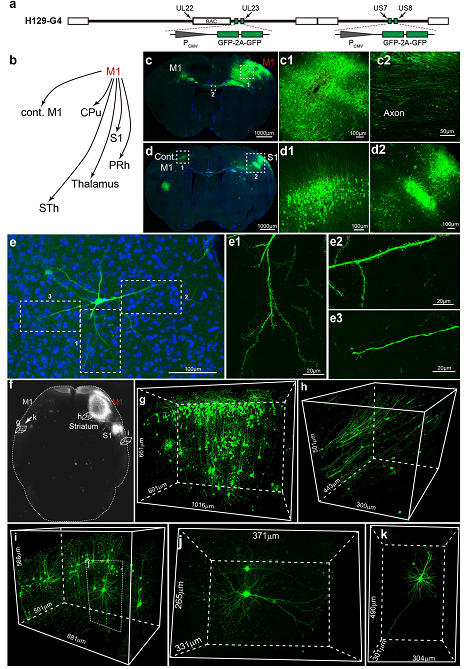H129 was used as a potential novel anterograde monosynaptic tracer. (From
BrainVTA)
The viruses used in this article are in the table below
Wen-Bo Zeng, Hai-Fei Jiang, Ya-Dong Gang, Yi-Ge Song, Zhang-Zhou Shen, Hong Yang, Xiao Dong, Yong-Lu Tian, Rong-Jun Ni, Yaping Liu, Na Tang, Xinyan Li, Xuan Jiang, Ding Gao, Michelle Androulakis, Xiao-Bin He, Hui-Min Xia, Ying-Zi Ming, Youming Lu, Jiang-Ning Zhou, Chen Zhang, Xue-Shan Xia, Yousheng Shu, Shao-Qun Zeng, Fuqiang Xu, Fei Zhao, Min-Hua Luo
Pub Date: 2017-05-14,
DOI: 10.1186/s13024-017-0179-7,
Email: [email protected]
Background: Herpes simplex virus type 1 strain 129 (H129) has represented a promising anterograde neuronal circuit tracing tool, which complements the existing retrograde tracers. However, the current H129 derived tracers are multisynaptic, neither bright enough to label the details of neurons nor capable of determining direct projection targets as monosynaptic tracer.
Methods: Based on the bacterial artificial chromosome of H129, we have generated a serial of recombinant viruses for neuronal circuit tracing. Among them, H129-G4 was obtained by inserting binary tandemly connected GFP cassettes into the H129 genome, and H129-ΔTK-tdT was obtained by deleting the thymidine kinase (TK) gene and adding tdTomato coding gene to the H129 genome. Then the obtained viral tracers were tested in vitro and in vivo for the tracing capacity.
Results: H129-G4 is capable of transmitting through multiple synapses, labeling the neurons by green florescent protein, and visualizing the morphological details of the labeled neurons. H129-ΔTK-tdT neither replicates nor spreads in neurons alone, but transmits to and labels the postsynaptic neurons with tdTomato in the presence of complementary expressed TK from a helper virus. H129-ΔTK-tdT is also capable to map the direct projectome of the specific neuron type in the given brain regions in Cre transgenic mice. In the tested brain regions where circuits are well known, the H129-ΔTK-tdT tracing patterns are consistent with the previous results.
Conclusions: With the assistance of the helper virus complimentarily expressing TK, H129-ΔTK-tdT replicates in the initially infected neuron, transmits anterogradely through one synapse, and labeled the postsynaptic neurons with tdTomato. The H129-ΔTK-tdT anterograde monosynaptic tracing system offers a useful tool for mapping the direct output in neuronal circuitry. H129-G4 is an anterograde multisynaptic tracer with a labeling signal strong enough to display the details of neuron morphology.
 Figure 1. H129 derived tracer H129-G4.
Figure 1. H129 derived tracer H129-G4.
In the present study, the authors introduce a potential novel anterograde monosynaptic tracer H129-ΔTK-tdT and a bright anterograde multisynaptic tracer H129-G4. With helper virus complementarily expressing TK, H129-ΔTK-tdT can potentially transmit to the postsynaptic neurons, and enable visualization of direct projection targets of either a given brain nucleus or a specific neuron type. H129-G4 may label the multisynaptic projection circuit with high labeling intensify, which helps to visualize the details of neuron morphology along the circuits. These novel anterograde tracers offer novel tools for projectome mapping, and complement the existing neuronal circuit tracing tool box.
BrainVTA offers viral vector construction & virus packaging services for AAV, LV, RABV, PRV, HSV and VSV that help researchers explore questions about genes, neurons, circuitry structure, function of brain network, mechanism and treatment of diseases.
If you have any needs, just email us at
[email protected].
